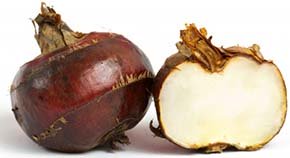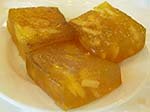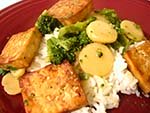Chinese water chestnuts Nutrition facts
Water chestnuts are nutritious tubers (corms) grown for their mildly sweet, delicious, coconut-like crunchy textured edible pulp. The corms are cultivated in wet fields and used as vegetables in many parts of Asia, particularly in China, Japan, South Korea, and Vietnam.
Botanically, waterchestnut belongs to the Cyperaceae (sedge) family of grass-like aquatic plants; in the genus: Eleocharis.
Scientific name: Eleocharis dulcis.
The corms, known as haeo (แห้ว) in Thai, and biqi (荸荠) or matai (马蹄)in the Cantonese are quite popular for their nutty, crispy texture in the dishes.
 |
| Chinese Waterchestnuts. |
Water chestnut tubers are native to the marshy, still, or slow-moving water plains (wetlands) of South-East Asia.
The Waterchestnut plant produces numerous, round, corms below the soil, which are ready for harvesting when its leaves turn yellow. The bulbs feature coarse dark brown skin, measure about 5 cm in diameter, and weigh 30 g. Inside, its crispy, white-fleshed flesh is mildly sweet and has a pleasant aroma.
Chinese water chestnuts should not be confused with European water caltrops (T. natans), which also recognized as western water chestnuts in the markets.
Health benefits of Chinese Water Chestnuts
Water chestnuts carry slightly more calories than sweet potatoes at 97 calories per 100 grams. Their calorie value chiefly comes from complex carbohydrates, amylose, and amylopectin.
They carry a high-quality phytonutrient profile comprising of dietary fiber, and antioxidants in addition to moderate proportions of minerals, and vitamins.
Crunchy water chestnut corms are a good source of dietary fiber. 100 g of flesh provides 3 g or 8% of the daily requirement of dietary fiber. Together with slow-digesting complex carbohydrates, fibers in the food check sudden spurt in the blood sugar levels.
The corms are indeed natural sources of phenolic antioxidant; ferulic acid. In addition to free radical scavenging function, ferulic acid possesses blood pressure controlling, anti-diabetic, photo-protection against UV rays, and anti-cancer properties.
It also contains good levels of some of the valuable B-complex group of vitamins such as pyridoxine (25% of RDA), folates, riboflavin (15%), pantothenic acid (9.5%), and thiamin.
Further, the corms provide healthy amounts of some of the essential minerals like zinc, magnesium, copper (36% of RDA), manganese, phosphorus, and manganese. they also carry moderate amounts of potassium; 330 mg/100 g (7% of RDA). Potassium is an essential component of cells and body fluids that help regulate heart rate and blood pressure.
| Principle | Nutrient Value | Percent of RDA |
|---|---|---|
| Energy | 97 kcal | 5% |
| Carbohydrates | 23.94 g | 18% |
| Protein | 1.40 g | 2.5% |
| Total Fat | 0.10 g | 0.5% |
| Cholesterol | 0 mg | 0% |
| Dietary Fiber | 3 g | 8% |
| Vitamins | ||
| Folates | 16 µg | 4% |
| Niacin | 0.100 mg | <1% |
| Pantothenic acid | 0.479 mg | 9.5% |
| Pyridoxine | 0.129 mg | 25% |
| Riboflavin | 0.200 mg | 15% |
| Thiamin | 0.140 mg | 12% |
| Vitamin A | 0 IU | 0% |
| Vitamin C | 4 mg | 7% |
| Vitamin E | 1.2 mg | 8% |
| Vitamin K | 0.3 µg | <% |
| Electrolytes | ||
| Sodium | 41 mg | 3% |
| Potassium | 330 mg | 7% |
| Minerals | ||
| Calcium | 11 mg | 1% |
| Copper | 0.326 mg | 36% |
| Iron | 0.06 mg | <% |
| Magnesium | 22 mg | 5.5% |
| Manganese | 0.331 mg | 14% |
| Phosphorus | 63 mg | 9% |
| Zinc | 0.50 mg | 4.5% |
Selection and storage
In its growing places, Chinese water chestnuts can be available at their best from the onset of the summer season to fall. In the US, they are sold primarily in Asian specialty stores or as canned in supermarkets. Choose that are fresh and very hard. Avoid bruises or ones that have soft spots.
Water chestnuts are fairly fragile, so it is best to store them unpeeled. They keep well in the fridge for 2 weeks, in a container, and covered with water. Fresh, unwashed water chestnuts can be also placed for 2 weeks in a paper bag and stored in the coldest part of the fridge. They need to be checked regularly, as they can start to dry out or ferment. Peeled water chestnuts keep for 2-3 days. Refrigerate any uneaten canned water chestnuts in water, replacing them with fresh water every day. Wholesale marketers store them in the freezer for up to 6 months, raw and plunged.
Cooking makes water chestnuts slightly sweeter and preserves their crunchy texture.
Preparation and serving methods
Only water chestnuts of E. dulcis species can be eaten raw. Peeled corms can be used boiled, braised, in stir-fries, etc. Peeled chestnuts can be used as a whole, halved, sliced, diced, julienned, or pureed. They add a characteristic crunchy note to many dishes.
Here are some serving tips:
 |
 |
| Pan fried waterchestnut cake. (Photo-by tissue_fleur) | Tofu, broccoli and waterchestnuts. (Photo-by Q family) |
In mainland China, pureed water chestnut is used in dim sum preparation.
Sliced/diced, they can be added to soups, mixed salads, fruit salads, vegetable-based dishes, pasta dishes and quiches, meat, poultry, and seafood.
Waterchestnut cake (matai gau) is a delicious recipe prepared during the Chinese New Year (autumn) festival in Southern China, and Hong Kong.
Water chestnut puree can be added to chicken stock with onions, apples and a light cream, or to potato, sweet potato or pumpkin.
Safety profile
Being water-dwelling crops, water chestnuts may harbor fluke larvae (Fasciolopsis). Fresh chestnuts should be washed thoroughly in running water, soaked in saltwater for at least 30 minutes, and rewashed again before eating them raw. Boiling kills the larvae instantly and any cooked recipes are safe for consumption. (Medical disclaimer).
≺≺ Back to Vegetables from Chinese water chestnuts. Visit here for an impressive list of vegetables with complete illustrations of their nutrition facts and health benefits.
≺≺ Back to Home page.
Further reading:
Eleocharis dulcis-Missouri Botanical Garden.
Ferulic acid-pdf